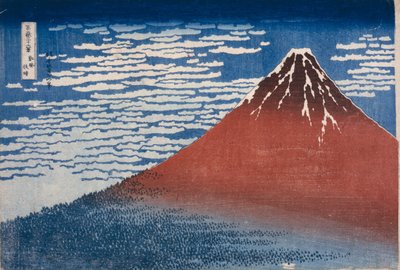Katsushika Hokusai was born in 1760 in Edo, now the Sumida district of Tokyo. He is considered Japan's most famous artist. His most famous work is probably the woodblock print "The Great Wave off Kanagawa" (1830) from the cycle "36 Views of Mount Fuji" (1829-1833). His works are assigned to the genre of ukiyo-e. It means "pictures of the flowing world", an animated, interconnected world in its eternal cycle of becoming and passing away. Hokusai drew, painted and printed nature and landscape paintings, portraits, everyday scenes and erotic depictions. The term "manga" also goes back to him. This was the name he gave to his sketchbooks of everyday scenes from the Edo period.
Katsushika Hokusai gave himself over 30 different artist names during his life. Between 1834 and 1849, he signed his works "Gakyo-rojin", Japanese for "Old man crazy about painting".
"At the age of 100 I will have reached an excellent rank, and at 110 every dot, every line will have a life of its own. I only hope that some people will grow old enough to realize the truth of my words."
Although he was not granted the 110 years of life, the prolific and grandiose artist left behind over 30,000 works. The magic of his visually powerful and subtle works continues to this day.
×





.jpg)
.jpg)
.jpg)
.jpg)
.jpg)
.jpg)
_-_(MeisterDrucke-926686).jpg)
_-_(MeisterDrucke-926686).jpg)
.jpg)
.jpg)
.jpg)
.jpg)
_-_(MeisterDrucke-394074).jpg)
_-_(MeisterDrucke-394074).jpg)
_-_(MeisterDrucke-368837).jpg)
_-_(MeisterDrucke-368837).jpg)
.jpg)
.jpg)
_-_(MeisterDrucke-276285).jpg)
_-_(MeisterDrucke-276285).jpg)
.jpg)
.jpg)
.jpg)
.jpg)
.jpg)
.jpg)
.jpg)
.jpg)
.jpg)
.jpg)
.jpg)
.jpg)
.jpg)
.jpg)
_-_(MeisterDrucke-308028).jpg)
_-_(MeisterDrucke-308028).jpg)
 from an untitled series known as Small Flowers - (MeisterDrucke-16474).jpg)
 from an untitled series known as Small Flowers - (MeisterDrucke-16474).jpg)
 also known as the Great Wave from the series T - (MeisterDrucke-16018).jpg)
 also known as the Great Wave from the series T - (MeisterDrucke-16018).jpg)
.jpg)
.jpg)
_also_known_as_the_Great_Wave_-_(MeisterDrucke-857432).jpg)
_also_known_as_the_Great_Wave_-_(MeisterDrucke-857432).jpg)
.jpg)
.jpg)
_from_-_(MeisterDrucke-1301462).jpg)
_from_-_(MeisterDrucke-1301462).jpg)
_-_(MeisterDrucke-906869).jpg)
_-_(MeisterDrucke-906869).jpg)
.jpg)
.jpg)
.jpg)
.jpg)
.jpg)
.jpg)
_-_(MeisterDrucke-183852).jpg)
_-_(MeisterDrucke-183852).jpg)
_-_(MeisterDrucke-229672).jpg)
_-_(MeisterDrucke-229672).jpg)
.jpg)
.jpg)
.jpg)
.jpg)
.jpg)
.jpg)
.jpg)
.jpg)
.jpg)
.jpg)
.jpg)
.jpg)
.jpg)
.jpg)
_-_(MeisterDrucke-926842).jpg)
_-_(MeisterDrucke-926842).jpg)
.jpg)
.jpg)
.jpg)
.jpg)


.jpg)
.jpg)
.jpg)
.jpg)
.jpg)
.jpg)
.jpg)
.jpg)
_-_(MeisterDrucke-108035).jpg)
_-_(MeisterDrucke-108035).jpg)
.jpg)
.jpg)
.jpg)
.jpg)
.jpg)
.jpg)
.jpg)
.jpg)
.jpg)
.jpg)
_-_(MeisterDrucke-906965).jpg)
_-_(MeisterDrucke-906965).jpg)
.jpg)
.jpg)
.jpg)
.jpg)
.jpg)
.jpg)
.jpg)
.jpg)
.jpg)
.jpg)
.jpg)
.jpg)
_-_(MeisterDrucke-926884).jpg)
_-_(MeisterDrucke-926884).jpg)
.jpg)
.jpg)
.jpg)
.jpg)
.jpg)
.jpg)
.jpg)
.jpg)
.jpg)
.jpg)
.jpg)
.jpg)
.jpg)
.jpg)
.jpg)
.jpg)
.jpg)
.jpg)
Fuk_-_(MeisterDrucke-1365479).jpg)
Fuk_-_(MeisterDrucke-1365479).jpg)
Fukujuso_(series_title)_-_(MeisterDrucke-1364091).jpg)
Fukujuso_(series_title)_-_(MeisterDrucke-1364091).jpg)
_19th_century_Paris_M_-_(MeisterDrucke-1004716).jpg)
_19th_century_Paris_M_-_(MeisterDrucke-1004716).jpg)
.jpg)
.jpg)
.jpg)
.jpg)
_-_(MeisterDrucke-394079).jpg)
_-_(MeisterDrucke-394079).jpg)
_also_known_as_The_Great_Wave_-_(MeisterDrucke-1298499).jpg)
_also_known_as_The_Great_Wave_-_(MeisterDrucke-1298499).jpg)
_-_(MeisterDrucke-74042).jpg)
_-_(MeisterDrucke-74042).jpg)
_from_an_untitled_series_of_flow_-_(MeisterDrucke-1297566).jpg)
_from_an_untitled_series_of_flow_-_(MeisterDrucke-1297566).jpg)
_also_known_as_The_Great_Wave_-_(MeisterDrucke-1293223).jpg)
_also_known_as_The_Great_Wave_-_(MeisterDrucke-1293223).jpg)
.jpg)
.jpg)
.jpg)
.jpg)
.jpg)
.jpg)
.jpg)
.jpg)
_-_(MeisterDrucke-241547).jpg)
_-_(MeisterDrucke-241547).jpg)
.jpg)
.jpg)
.jpg)
.jpg)
.jpg)
.jpg)
.jpg)
.jpg)
.jpg)
.jpg)
.jpg)
.jpg)
.jpg)
.jpg)
 from the series Thirty-six Views of Mount Fuji (Fugaku sanjur - (MeisterDrucke-16540).jpg)
 from the series Thirty-six Views of Mount Fuji (Fugaku sanjur - (MeisterDrucke-16540).jpg)
.jpg)
.jpg)
.jpg)
.jpg)
.jpg)
.jpg)
.jpg)
.jpg)
.jpg)
.jpg)
.jpg)
.jpg)
.jpg)
.jpg)
.jpg)
.jpg)
.jpg)
.jpg)




